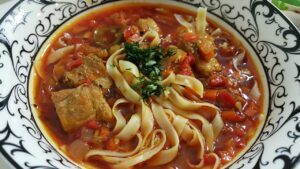A Taste of Tradition: Exploring the Richness of Russian Borscht

Introduction: In the colorful tapestry of Russian cuisine, few dishes stand out with the same vibrancy and warmth as borscht. This iconic beet soup is not just a culinary delight but a cultural cornerstone, deeply rooted in the traditions and heritage of Russia. Join us on a journey as we unravel the layers of flavor, history, and symbolism behind this beloved dish.
Origins and History: Borscht’s origins can be traced back centuries to the lands of Eastern Europe, where it was enjoyed by peasants and nobility alike. While the exact origins of borscht are debated, it is widely believed to have originated in Ukraine before spreading to neighboring regions, including Russia. Over time, borscht became a staple of Russian cuisine, evolving to reflect regional variations and personal preferences.
Ingredients and Flavors: At its core, borscht is a beet soup known for its deep crimson color and robust flavor. While the basic ingredients of borscht include beets, cabbage, potatoes, carrots, onions, and broth, the variations are endless. Some recipes call for the addition of meat, such as beef or pork, which adds richness and depth to the soup. Others prefer a vegetarian version, showcasing the natural sweetness and earthiness of the vegetables.
The key to borscht’s distinctive flavor lies in its combination of ingredients and seasonings. Beets are the star of the show, imparting their vibrant color and earthy sweetness to the soup. Cabbage adds texture and bulk, while carrots and potatoes provide sweetness and substance. Onions and garlic add aromatic depth, while a splash of vinegar or lemon juice brightens the flavors and balances the sweetness of the vegetables.
Preparation and Serving: Preparing borscht is a labor of love that begins with selecting the freshest ingredients and taking the time to coax out their flavors. The beets are peeled, diced, and simmered until tender, infusing the broth with their rich color and earthy sweetness. Meanwhile, the other vegetables are chopped and added to the pot, along with any meat or additional seasonings.
Once all the ingredients have melded together, the soup is ladled into bowls and served piping hot, often garnished with a dollop of sour cream and a sprinkle of fresh dill. The sour cream adds a creamy richness to the soup, while the dill adds a burst of freshness and aroma. Borscht is traditionally served with a slice of dark rye bread, perfect for soaking up every last drop of broth.
Cultural Significance: Beyond its culinary appeal, borscht holds a special place in Russian culture and traditions. It is a dish that evokes memories of home, family, and shared meals around the dinner table. Borscht is often served during holidays and special occasions, where it symbolizes abundance, hospitality, and togetherness.
In addition to its cultural significance, borscht has also been celebrated in art, literature, and folklore. It has inspired countless poems, stories, and paintings, capturing the essence of Russian life and identity. Whether enjoyed in a bustling kitchen or a cozy dining room, a bowl of borscht is not just a meal—it is a taste of tradition, history, and the enduring spirit of Russia.
Conclusion: In the tapestry of Russian cuisine, borscht stands as a timeless symbol of warmth, flavor, and heritage. From its humble origins to its place on dinner tables around the world, borscht is more than just a soup—it is a culinary masterpiece that continues to delight and inspire. So the next time you crave a taste of tradition, reach for a bowl of borscht and savor the richness of Russian culture in every spoonful.





